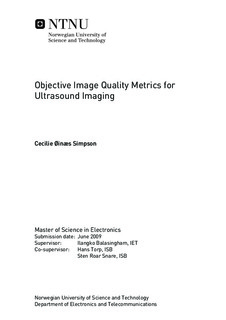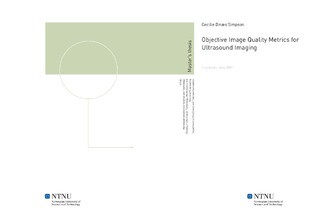| dc.contributor.advisor | Balasingham, Ilangko | nb_NO |
| dc.contributor.author | Simpson, Cecilie Øinæs | nb_NO |
| dc.date.accessioned | 2014-12-19T13:43:41Z | |
| dc.date.accessioned | 2015-12-22T11:41:20Z | |
| dc.date.available | 2014-12-19T13:43:41Z | |
| dc.date.available | 2015-12-22T11:41:20Z | |
| dc.date.created | 2010-09-03 | nb_NO |
| dc.date.issued | 2009 | nb_NO |
| dc.identifier | 347762 | nb_NO |
| dc.identifier.uri | http://hdl.handle.net/11250/2369181 | |
| dc.description.abstract | Objective evaluation of the image quality on ultrasound images is a comprehensive task due to the relatively low image quality compared to other imaging techniques. It is desirable to objectively determine the quality of ultrasound images since quantification of the quality removes the subjective evaluation which can lead to varying results. The scanner will also be more user friendly if the user is given feedback on the quality of the current image. This thesis has investigated in the objective evaluation of image quality in phantom images. It has been emphasized on the parameter spatial variance which is incorporated in the image analysis system developed during the project assignment. The spatial variance was tested for a variety of settings as for instance different beam densities and number of MLAs. In addition, different power spectra have been evaluated related to the ProbeContact algorithm developed by the Department of Circulation and Medical Imaging (ISB). The algorithm has also been incorporated in the image analysis system. The results show that the developed algorithm gives a good indication of the spatial variance. An image gets more and more spatially variant as the beam density decreases. If the beam density goes below the Nyquist sampling limit, the point target will appear to move more slowly when passing a beam since the region between the two beams are undersampled. This effect will be seen in the correlation coefficient plots which is used as a measure of spatial variance. The results from the calculations related to the ProbeContact algorithm show that rearranging the order of the averaging and the Fourier transformation will have an impact on the calculated probe contact, but the differences are tolerable. All the evaluated methods can be used, but performing Fourier transform before averaging can be viewed as the best solution since it gives a lateral power spectrum with low variance and a smooth mean frequency and bandwidth when they are compared for several frames. This is suggested with the reservations of that basic settings are used. Performing 1D (in the lateral direction) or 2D Fourier transform before averaging will not have any impact of the resulting power spectrum as long as normalized Fourier tranform is used. The conclusion is that the image analysis system, including the spatial variance parameter, is a good tool for evaluating various parameters related to image quality. The system is improved by the ProbeContact algorithm which gives a good indication of the image quality based on the acoustic contact of the probe. Even though the image analysis system is limited to phantom images, the thesis is a starting point in the process of obtaining objective evaluation of the image quality in clinical images since others may use it as a basis for their work. | nb_NO |
| dc.language | eng | nb_NO |
| dc.publisher | Institutt for elektronikk og telekommunikasjon | nb_NO |
| dc.subject | ntnudaim | no_NO |
| dc.title | Objective Image Quality Metrics for Ultrasound Imaging | nb_NO |
| dc.type | Master thesis | nb_NO |
| dc.source.pagenumber | 87 | nb_NO |
| dc.contributor.department | Norges teknisk-naturvitenskapelige universitet, Fakultet for informasjonsteknologi, matematikk og elektroteknikk, Institutt for elektronikk og telekommunikasjon | nb_NO |

